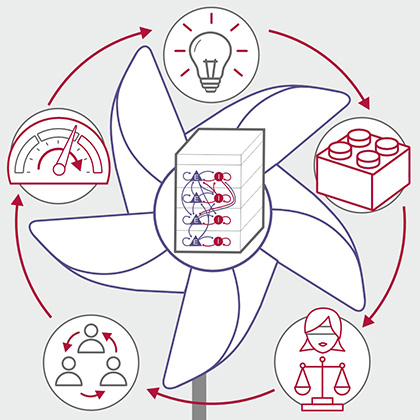Bernstein Network News. Find the latest news from our researchers regarding current research results, new research projects and initiatives as well as awards and prizes.
What mitochondria reveal about the brain
International researchers have analysed the distribution of mitochondria, the energy producers of cells, in the brain. The results offer new perspectives on the organisation of neuronal networks and their performance.
Gottfried Wilhelm Leibniz Prize awarded to Klaus-Robert Müller
The main committee of the German Research Foundation (DFG) today announced the recipients of the Gottfried Wilhelm Leibniz Prize, considered the highest honor for researchers in Germany. Among the ten awardees is Prof. Dr. Klaus-Robert Müller, co-director of BIFOLD and head of the Machine Learning Group at TU Berlin. He is regarded as a pioneer of machine learning and has been driving this important area of artificial intelligence (AI) since 1989. His work combines excellence in formal mathematical reasoning with a strongly application-oriented approach. His interdisciplinary method brings together fields such as biology, medicine, chemistry, mathematics, and computer science.
Recognition for cutting-edge research
Neuroscientist Professor Dr. Kristine Krug from Otto von Guericke University Magdeburg has once again been appointed Visiting Professor of Neuroscience at the renowned University of Oxford in the UK. The Medical Sciences Board at Oxford University confirmed the unpaid title for a further five years.
Quantum sensors: Highly precise measurements in moving brains
What is happening in the brain during an epileptic seizure? How do nerve cells function after a stroke-induced paralysis? What happens in the heads of those suffering from Parkinson’s disease? Investigating these types of questions has been difficult up to now because patients had to keep still. However, Optical Pumped Magnetoencephalography (OPMEG) is making it possible to also scan the brain while the patient is moving. Prof. Dr. Dominik Bach, Hertz Chair for Artificial Intelligence and Neuroscience at the University of Bonn, is currently setting up this type of research infrastructure on the campus of the University Hospital Bonn (UKB) and will receive funding of almost four million euros over the next three years from the EFRE/JTF program run by the European Union and the state government of North Rhine-Westphalia.
Ten years of PD14: milestone model shapes digital neuroscience and AI research
Neuronal circuit models help researchers better understand how nerve cells in the brain work together and can be used computationally to advance brain research. A key step toward computational neuroscience was the model of early sensory cortex developed by Dr. Tobias Potjans and Prof. Markus Diesmann, known as PD14. Published in 2014, it has become a research standard – as a basis for more complex brain models, as a testbed for computational methods, and as a benchmark for the performance of new computer systems.
In April 2024, researchers from around the world met at the Käte Hamburger Center for Advanced Study in the Humanities “Cultures of Research” at RWTH Aachen University to reflect on the model’s importance for work in computational and theoretical neuroscience on the occasion of its tenth anniversary. The results of the symposium have now been published in the journal Cerebral Cortex. In this interview, Prof. Markus Diesmann and Prof. Hans Ekkehard Plesser, lead author of the report, discuss the significance of PD14 and the opportunities and challenges of digital neuroscience, as illustrated for example by the European research platform EBRAINS.
Biological intelligence as the basis for new AI systems
A new project led by the CIMH is investigating how insights into learning processes in animal brains can be used to make artificial intelligence more flexible and efficient.
When AI “thinks” like us
Even though so-called Vision Foundation models, computer models for automated image recognition, have made enormous progress in recent years, they still differ significantly from human visual understanding. For example, they generally do not capture multi-level semantic hierarchies and have difficulty with relationships between semantically related but visually dissimilar objects. In a joint project with Google DeepMind, scientists from TU Berlin, Max-Planck-Institute for Human Cognitive and Brain Sciences, and MPI for Human Development have generated a new approach called ‘AligNet,’ which integrates human semantic structures into neural image processing models for the first time, thereby bringing the visual understanding of computer models closer to that of humans. The results have now been published in the renowned journal Nature under the title ‘Aligning Machine and Human Visual Representations across Abstraction Levels’.
Software optimizes simulations of the brain
A new software enables brain simulations which both imitate the processes in the brain in detail and can solve challenging cognitive tasks. The program was developed by a research team at the Cluster of Excellence ‘Machine Learning: New Perspectives for Science’ at the University of Tübingen. The software thus forms the basis for a new generation of brain simulations which allow deeper insights into the functioning and performance of the brain. The Tübingen researchers’ paper has been published in the journal Nature Methods.
FAU researchers corroborate the theory of cognitive linguistics
AI models are able to derive the rules of human language without being provided with explicit information about grammar and word classes. This is the conclusion reached by researchers at Friedrich-Alexander-Universität Erlangen-Nürnberg (FAU). Their experiment corroborates the theory of cognitive linguistics that states, in contrast to the theory of universal grammar, that we are not born with an inherent understanding of syntactical constructions, but that it is learned through using language. The results of the study have been published in the prestigious collective volume “Recent Advances in Deep Learning Applications: New Techniques and Practical Examples“.
Teamwork in the inner ear – our hearing is based on the organized grouping of proteins
Researchers at Göttingen Campus have succeeded for the first time in examining the tiny synapses in the inner ear — the points of contact between the hair cells and the auditory nerve cells — at the molecular level. They were able to show that ion channels and other synaptic proteins essential for hearing are organized in specific patterns. This arrangement ensures optimized transmission of auditory information to the brain. These findings could contribute to the development of therapies for hearing disorders with synaptic causes. The results have been published in the journal Science Advances.

















